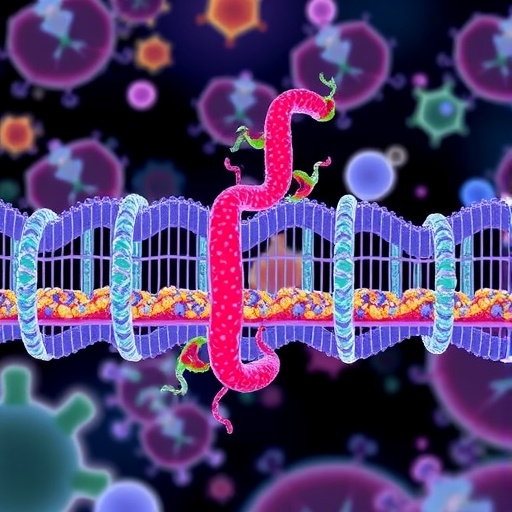Recent breakthroughs in the study of membrane proteins have unveiled a complex but fascinating mechanism of regulation through preferential lipid solvation. This research led by Bernhardt, Ozturk, Zhang, and a team of innovators at the forefront of biochemistry has significant implications for understanding membrane protein function in living systems. Membrane proteins are crucial for a range of biological processes, including signaling, transport, and maintaining cellular integrity. With their involvement in nearly every aspect of cell function, understanding how these proteins interact with their lipid surroundings takes on paramount importance.
The study focuses on the concept of preferential lipid solvation, a phenomenon where specific lipids preferentially interact with membrane proteins. This interaction alters the protein’s structure and dynamics, subsequently influencing its functionality. By investigating this process at the molecular level, the research team was able to dissect various components of the lipid-protein interface. They utilized advanced spectroscopic techniques, molecular simulations, and biophysical measurements to elucidate the intricate relationships between different lipid types and protein structures.
The findings reveal that not all lipids interact with membrane proteins equally; instead, certain lipid species provide a stabilizing effect on specific protein conformations. This indicates a dynamic equilibrium where the availability of various lipid environments can dictate functional states of membrane proteins. Such malleability could potentially give rise to a vast array of signaling mechanisms, making proteins more adaptable in fluctuating cellular environments.
Delving deeper, the research identified distinct classes of membrane proteins that respond differently to lipid solvation. For instance, while some proteins displayed robust functionality in the presence of membrane phospholipids, others were remarkably sensitive to specific lipid modifications. This suggests that the lipid composition of cellular membranes may serve as a regulatory switch, modulating protein activity according to physiological needs or environmental changes.
The implications of this discovery reach far beyond basic biology. Understanding the selective pressure exerted by lipid composition on membrane proteins could pave the way for novel targeted therapeutic strategies. With an increasing need for precise modulation of protein function in drug development, insights from this research could inform the design of new drugs that effectively manipulate membrane protein behavior by altering lipid interactions.
One of the standout revelations from the study was the relationship between lipid composition and protein interaction dynamics. This highlights a fascinating area of research that could redefine pharmacological approaches to diseases linked to membrane proteins. Diseases such as diabetes, neurodegenerative disorders, and cancer have complex associations with membrane protein dysfunction. By leveraging insights into lipid-protein interactions, new therapeutic avenues could be explored, potentially leading to innovative treatments and improved patient outcomes.
Fundamentally, this research prompts a reconsideration of the traditional views regarding protein environments. It emphasizes that the membrane is not merely a passive barrier but an active participant in signaling and functional processes. Such a paradigm shift calls for a more integrative approach in biochemical research, where both proteins and their lipid environments are studied in unison to better understand cellular mechanisms.
Furthermore, the technological advancements utilized in this research are noteworthy. The integration of molecular simulations with experimental data allowed the researchers to create a comprehensive picture of lipid-protein interactions. This multi-faceted approach showcases the necessity of combinatorial methodologies in modern biochemical research, encouraging collaboration across various scientific disciplines.
As the findings gain traction within the scientific community, they prompt several additional questions. How might variations in lipid metabolism affect membrane protein regulation? What implications might this have for diseases where lipid profiles are altered? Furthermore, how can this newfound knowledge be translated into practical applications in biotechnology or medicine? These questions reveal the potential for future inquiries that could deepen our understanding of the cellular milieu.
Ultimately, Bernhardt et al.’s research opens the doors to a plethora of possibilities in membrane biology. Beyond its immediate implications, it inspires curiosity about the molecular intricacies of life itself. As scientists continue to peel back layers of complexity surrounding membrane proteins and their lipid environments, we can anticipate even more significant revelations that may reshape our understanding of biology.
In conclusion, the molecular basis for the regulation of membrane proteins through preferential lipid solvation represents a significant leap in biochemistry. It offers a fresh perspective on protein functionality and opens new pathways for therapeutic intervention. As researchers build upon this foundation, the future of membrane biology looks promising, potentially leading to groundbreaking advancements in fields ranging from pharmacology to biotechnology.
Subject of Research: Membrane Proteins and Lipid Interactions
Article Title: Molecular basis for the regulation of membrane proteins through preferential lipid solvation
Article References:
Bernhardt, N., Ozturk, T.N., Zhang, S. et al. Molecular basis for the regulation of membrane proteins through preferential lipid solvation.
Nat Chem Biol (2025). https://doi.org/10.1038/s41589-025-02032-w
Image Credits: AI Generated
DOI: https://doi.org/10.1038/s41589-025-02032-w
Keywords: Membrane proteins, lipid solvation, protein regulation, cellular signaling, biochemistry.




